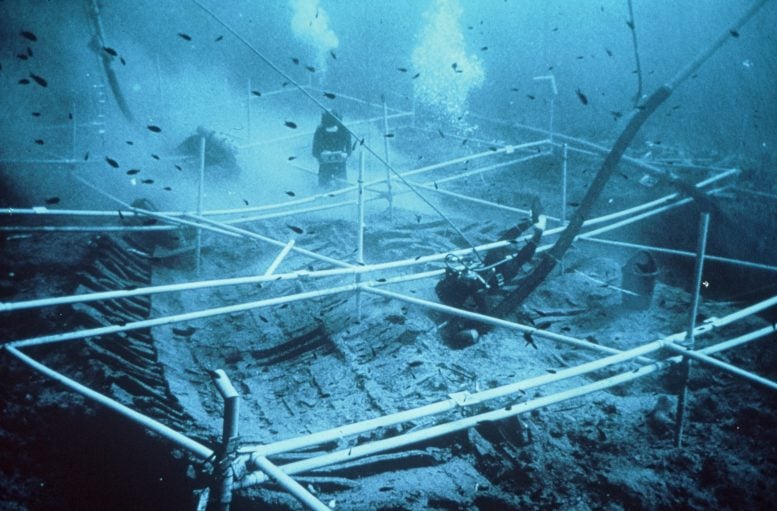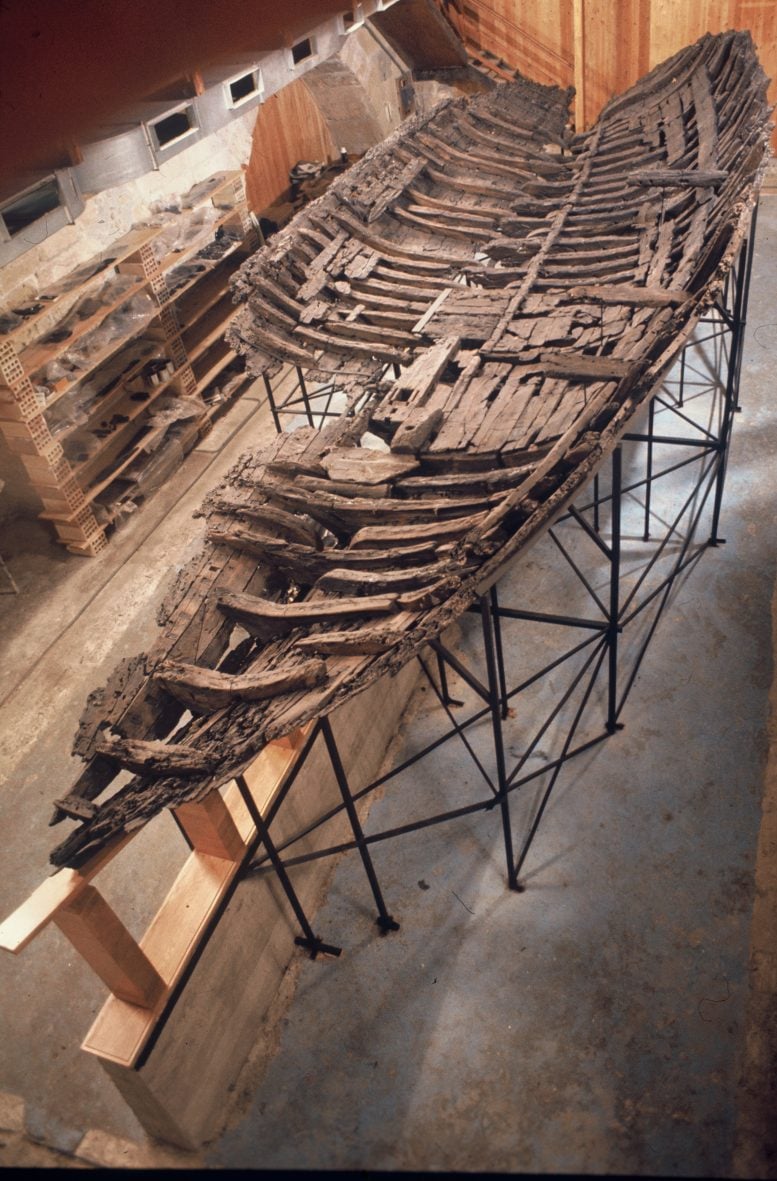
The hull of the Kyrenia ship during excavations. The hull of the Kyrenia ship on the seabed off Northern Cyprus during underwater excavations in the late 1960s. Credit: Image provided to the authors by the Kyrenia Ship Excavation team for use with this paper, CC-BY 4.0
Researchers from Cornell University have improved the estimated sinking period of the Kyrenia shipwreck to between 286-272 BC by overcoming dating challenges such as removing contaminants and revising the radiocarbon calibration curve, enhancing historical understanding and broader scientific research.
Historic shipwrecks often conjure dreams of sunken riches waiting to be reclaimed at the bottom of the ocean.
For researchers at Cornell University trying to date the famous Hellenistic-era Kyrenia shipwreck, which was discovered and recovered off the northern coast of Cyprus in the 1960s, the real treasure was not gold coins, but thousands of almonds found in jars among the cargo.
The almonds, combined with freshly cleaned wood samples and the team’s expertise in modeling and radiocarbon dating, led the Cornell Tree-Ring Laboratory to determine the most likely timeline for the sinking of Kyrenia between 296-271 B.C., with a strong possibility that it occurred between 286 B.C. Birth. -272 BC.
The team’s paper was recently published in the journal One plus. The lead author is Sturt Manning, Arts & Sciences Distinguished Professor of Classical Archeology in the College of Arts & Sciences.
The Kyrenia ship has a historical legacy as the first large Greek ship from the Hellenistic era to be found, in 1965, with a largely intact hull. From 1967 to 1969, it was excavated with its cargo, which included hundreds of ceramic vessels, then reassembled off-site and studied scientifically.
“Kyrenia was one of the first times it was realized that this kind of rich evidence from the Classical world could be found largely intact after more than 2,000 years on the sea floor, if you could find it,” Sturt Manning said. “It was a bit of a historical moment, the idea that you could actually dive and excavate and bring back a ship from the Classical era and thus discover this ancient world directly. Shipwrecks are unique time capsules, and you can get amazing preservation.”

The hull of the Kyrenia ship survives shortly after the wood recovered from seabed excavations was reassembled. Credit: Image provided to the authors by the Kyrenia Ship Excavation team for use with this paper, CC-BY 4.0
Over the past six decades, Kyrenia has provided archaeologists and historians with essential insights into the development of ancient ship technology, building practices, and maritime trade. To date, at least three replicas of Kyrenia have been produced and launched, and these reconstructions have yielded considerable information about the ancient ships and their sailing performance. However, the timeline of Kyrenia’s source and the exact date of its sinking has always been ambiguous at best. Initial efforts to date the ship were based on recovered artifacts, such as pottery found on board and a small collection of coins, which initially led researchers to estimate that the ship was built and sunk in the late 3rd century BC.
“Classical texts and finds at port sites tell us that this era was important for large-scale maritime trade and communications throughout the Mediterranean – an early period of globalization,” Manning said. “But the discovery of the Kyrenia, less than 15 meters long, and likely with a crew of four, made this whole thing very immediate and real. It yielded fundamental insights into the practicalities of the previous part of a millennium of intense maritime activity at sea.” The Mediterranean, from Greek times to late antiquity.
The first volume of the final publication of the Kyrenia Ark Project, released last year, said the date of the destruction was slightly later, closer to 294-290 BC, but the key piece of evidence – a poorly preserved, almost illegible coin – was not. water resistant.
Manning’s team, which included co-authors Madeline Wenger, ’24, and Britta Lorentzen, Ph.D., ’15, sought to secure a date to conduct the study.
Dangers of polyethylene glycol
The biggest obstacle to accurately dating Kyrenia has been another artifact, one from the 20th century: polyethylene glycol (PEG). Prospectors and conservationists often apply the petroleum compound to waterlogged wood to prevent it from decomposing after it is recovered from the oxygen-free ocean environment.
“PEG has been a standard treatment for decades. The problem is that it’s a petroleum product, which means if you have PEG in wood, you have this contamination from ancient fossil carbon that makes radiocarbon dating impossible,” Manning said.
Manning’s team worked with researchers at the University of Groningen in the Netherlands to develop a new method for cleaning wood of PEG, and they demonstrated this on PEG-treated Roman-era specimens from Colchester, England, which already had established dendrochronology (tree-ring sequences).
“We removed the PEG from the wood, radiocarbon-dated it, and showed that in each case, we obtained a radiocarbon age that matched the true (known) age,” Manning said. “We basically removed 99.9% of the PEG.”
They used the technique to remove PEG from a Kyrenia specimen that Manning and his collaborators had tried to accurately date 10 years earlier, but failed. The team also dated a small, twisted piece of wood that had been recovered from Kyrenia in the late 1960s but was too small to be included in the reconstruction, thus avoiding the binding treatment. It subsequently remained in a water jar in the museum for 50 years.
Dating has shown that the most recent tree rings preserved from these woods grew in the mid-4th century BC. Because the samples did not include bark, the researchers could not determine the exact date the original trees were felled, but they can say the date is likely after about 355-291 BC.
Organic evidence
Working with Kyrenia’s indigenous excavation team, the researchers examined various artifacts, including pottery and coins, with an emphasis on organic materials, including astragalus (the ankle bone of a sheep or goat that was used in games and divination rituals in many ancient cultures). Thousands of fresh green almonds are found in some large amphoras, i.e. ceramic jars. These “short-lived” samples helped determine the date of the ship’s last voyage.
The team applied statistical models combined with dendrochronology of the wood samples to obtain a level of dating that was more accurate than previous efforts. Modeling determined the most likely range of dates for the final voyage to be between 305-271 BC (95.4% probability) and 286-272 BC (68.3% probability) – several years later than current estimates.
But there was a big hiccup along the way. The new dates did not align with the international radiocarbon calibration curve, which is based on tree rings of known age and is used to convert radiocarbon measurements into Northern Hemisphere calendar dates.
Manning took a closer look at the data behind the calibration curve, compiled over many decades by dozens of laboratories and hundreds of scientists. He discovered that the period between 350 and 250 BC did not contain modern radiocarbon mass spectrometry (AMS) data. Instead, the calibration curve in this period was based on only a few measurements made in the 1980s and 1990s using an older type of radiocarbon dating technology. With collaborators in the United States and the Netherlands, the team measured known specimens of single-age sequoia and oak trees to recalibrate the curve for the period 433-250 BC. Not only did this help explain the spike in radiocarbon production caused by a minimum of solar activity centered around 360 BC, but it also led to important revisions of the curve in the period around 300 BC – improvements that were crucial in determining the dating of Kyrenia.
Manning expects the new results will not only clarify Kyrenia’s timeline and payload, but will also help researchers use the calibration curve for very different projects.
“This revised 400-250 BC curve now has relevance to other problems that researchers are working on whether in Europe, China or elsewhere in the Northern Hemisphere,” he said. “Half of the people who cite future research will cite the fact that we revised the radiocarbon calibration curve in this period, and only half of them will say that the Kyrenia shipwreck is really important and has a much better history.”
Reference: “Revised 350-250 BC radiocarbon calibration curve influences high-resolution dating of Kyrenia ship” by Sturt W. Manning, Britta Lorentzen, Martin Bridge, Michael WD, John Southon, and Madeleine Wenger, 26 Jun 2024, One plus.
doi: 10.1371/journal.pone.0302645

“Beer aficionado. Gamer. Alcohol fanatic. Evil food trailblazer. Avid bacon maven.”
